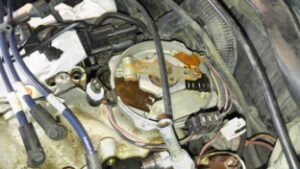Automotive repair has always been a hobby for me and something I enjoy. I’ve done repair and maintenance on all my cars for as long as I’ve had cars. I bought my 1985 Corvette not only to enjoy it but also to tinker with it. I’ve done many projects over the years which I will document in the coming months. This post is about C4 Corvette repair basics that I have learned over the years. In most cases, it could just be the basics for any car repair. Just helpful things to know in general especially if you’re new to automotive repair.
Having a good source of repair information is important too. Take a look at what repair manuals are available.
A beginners list of tools to start with
The right tools are key for doing any job. It’s amazing how just the right tools make a job so much easier. This is a great list for any work-at-home mechanics to start with. Depending on what you are working on there is always another tool you could use. That old saying you can’t have too many tools is especially true for auto repair. But this is a great list to get your toolbox started with.
- Hammers – It’s a good idea to have a big one and a small one. They are needed to sometimes help remove parts and items that are no longer needed, like brake rotors when doing a brake job. A rubber mallet as well is good to have.
- Ratchet and socket set – Best to start with a 3/8 inch set. There are lots of different options but going with a complete set is best with both metric and SAE sizes. Most vehicles use metrics including the C4 Corvettes but it is good to have SAE as well. There are lots of options to choose from depending on your budget. You can add 1/4 and 3/4 later.
- Screwdriver set – Get a set with flatheads and Philips. Just like the socket set, it’s easier and less expensive to go with a complete set. Flathead screwdrivers can be used for lots of different things with other tools that don’t work, including prying difficult or rusted parts apart.
- Pliers, vice grips channel locks – Too many ways to use these useful items including getting off rusted or stuck parts to just holding things together.
- Wrenches – Once again, purchase a set of metrics and SAE. Sockets are the usual go-to items but sometimes they won’t fit in the area you need to loosen a head. Wrenches are great for this purpose
- Extendable magnet – probably the most important tool there is. You’ll drop many important items somewhere you can’t reach and a magnet will save you many headaches along the way.
- Jumper cables – Obvious what these are for but a good set is important. Also, get the longest ones you can find or afford. It’s not always easy getting the batteries of the one that won’t start and the one being used to jump-start close together.
- Air pressure gage and pump – Always important to check your tire pressure and be able to add air when needed.
- Cordless Impact gun – Cordless has come a long way, a good impact gun will save you a lot of work and time. Get a good quality one here that will last a long time.
- Floor jack and jack stands – Every mechanic needs a good floor jack and jack stands. I also feel tire ramps are important too. Let’s dive into that more in the next section.
Working underneath a car
Make sure you are using the correct jacking points. Some serious damage can occur to the bottom of your vehicle if the correct jack points aren’t used. It appears someone at some point tried to jack up my 1985 Corvette in the wrong place and damaged the storage compartment so be careful.
A reliable floor jack is a necessity. But do not rely on just a floor jack. They can fail and you could be crushed under the vehicle. Use good quality jack stands to ensure your safety. I sometimes use both depending on the situation. Safety is a matter you should never compromise or take for granted.
Ramps are a helpful thing to have too. A lot of times instead of using jack stands I’ll use the ramps if I still have the wheels on. This depends on what you are working on.
Take pictures
It has saved me several times to take pictures of the project I’m working on while tearing it apart. Things are easy to take apart, but putting them back together is another matter. While doing my intake manifold gasket and china wall repair I snapped pictures as I removed parts. Without those pictures, it would have been very difficult and a lot more time-consuming to put everything back together since it was a project I had never done before. It was the simple things like hoses that I needed the pictures for but this definitely would have caused me problems if I didn’t get them attached correctly.
Good lighting in your work area
Another common tool that you’ll use while working on cars is a flashlight. This is useful for a variety of different things, such as inspection and seeing inside the engine. There are many types of flashlights that you can use for car repair, but it’s important to find one that’s powerful enough for your needs. Many portable flashlights are powerful enough for basic car repair, but you may wish to consider a heavy-duty flashlight or a LED work light if you’re planning on doing extensive work. I would go cheap here, these things break or get stepped on frequently so it’s easier to just get a new one. Also, you won’t be too upset when one gets destroyed.
Conclusion
The correct tools can make all the difference in doing repairs on your vehicle whether it’s a C4 Corvette repair or any other vehicle. This list is a good starting point for what to have for car repair. On a limited budget? Just purchase the basics and acquire new tools as you go when the item is needed. Another thought on saving money on tools, you can always go with used tools. These can be found at garage sales or sold online (Craigslist) or even at your local flea market. Just be careful and check out the tool before spending your hard-earned money. There are usually no returns on used tools.
Have other suggestions for what basic tools to start with? Leave a comment or suggestion in the comment section below.

